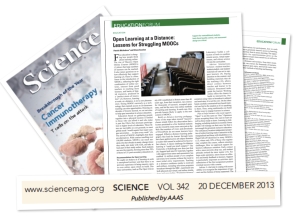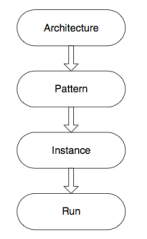Published in Science!
December 21, 2013 Leave a comment
 In my mini-series of posts on papers there is a brand new one that I am rather proud of. The paper came out of conversations with Eileen Scanlon just after we heard that she was to become the new Regius Chair in Open Education. The focus was around the “known knowns” of open education, particularly as there has been a slightly strange period of reinvention of ideas for online and distance education around MOOCs. The idea of known knowns is actually quite useful (but the resonance with Donald Rumfeld’s statement is not) and so we have refined the approach leading to a short (2-page) article that is appearing in the Educational Focus section of Science Magazine. This reflects a very kind connection from Candace Thille (my co-Director on OLnet when she was with the Open Learning Initiative at Carnegie Mellon University) and the great support of Brad Wible the editor at Science.
In my mini-series of posts on papers there is a brand new one that I am rather proud of. The paper came out of conversations with Eileen Scanlon just after we heard that she was to become the new Regius Chair in Open Education. The focus was around the “known knowns” of open education, particularly as there has been a slightly strange period of reinvention of ideas for online and distance education around MOOCs. The idea of known knowns is actually quite useful (but the resonance with Donald Rumfeld’s statement is not) and so we have refined the approach leading to a short (2-page) article that is appearing in the Educational Focus section of Science Magazine. This reflects a very kind connection from Candace Thille (my co-Director on OLnet when she was with the Open Learning Initiative at Carnegie Mellon University) and the great support of Brad Wible the editor at Science.
Working with Eileen has been a very good experience and has taken us back to looking at the history and writings on what we know through 40 years of being The Open University, coping with the way things are changing but also the way things remain the same. The article is very short and had many references trimmed in the edit so I hope we can go on to produce a longer version giving more of the background. Brevity does mean focus, and I think that we have kept the four main lessons we wanted to communicate and also some of the lessons that matter more for science education (Eileen’s own focus area for many years).
The article also grew a stronger link to MOOCs. The first version tried hard not to mention them as there is actually much more going on in open education than just MOOCs. The title in the end though does capture some of the intent to encourage people to not reinvent, rather learn. The four lessons from the article can be summarised as:
- Build on distance learning pedagogy. Starting from classroom experience misses on what we know about engaging learners at a distance.
- Plan to help learners who need support. MOOCs most easily meets the needs of the experience but offers a path for those under served by other educational offerings. If we can push ourselves further to design for their needs then everyone will gain.
- Recognise the power of well-designed assessment. Self-directed learning needs integration and motivation to make sense for the learner. Bringing in assessment in intelligent ways can make all the difference to enable a learning experience to make sense for the learner and for society.
- Ensure quality by working together. Working in the open and online also means that we have different ways of working. Building a complete organisation, such as the OU, does not need to be the answer but there are three steps to quality that should be there: judge whether fit for broadcast, bring people together, and test the technology. In brief always ask at least one person whose opinion you respect “is this ok?”.
The article itself is now out in the 20 December edition of Science, though they have a relatively enlightened attitude to republishing so I think we will be able to provide open access to our article in time.






Recent Comments